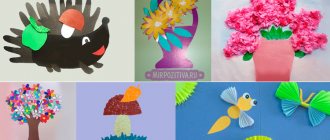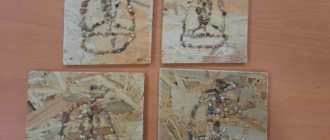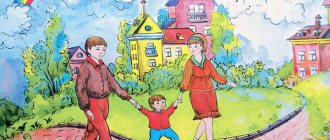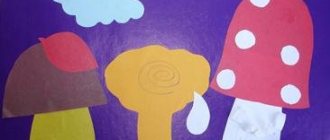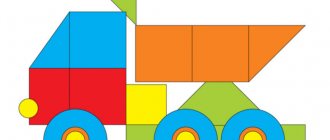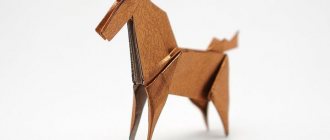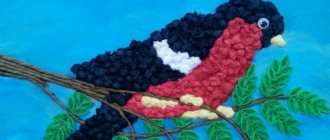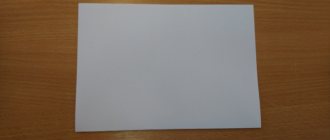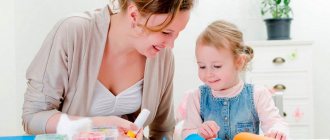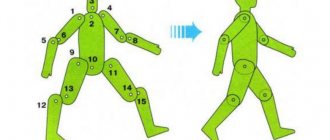Features of conducting appliqué classes in the senior group
Applique is the creation of subject or subject compositions from shaped elements or patterns cut out of paper, dry leaves, fabric, leather attached to a base (cardboard, wood, fabric). The multi-colored composition can be attached by gluing or sewing. This type of creative modeling has a beneficial effect on the development of fine motor skills, figurative and spatial thinking, sensory perception and the child’s intellectual abilities for synthesis and analysis.
Older preschoolers create their works in the appliqué genre, both with the help of ready-made templates or stencils, and on their own, mastering the technical skills of working with scissors, glue and paper, gradually showing their imagination more and more vividly in the images of multi-colored compositions on paper. For pupils of the senior group there are no thematic restrictions in conducting appliqué classes. These can be literary or fairy-tale scenes, holiday cards, images of vehicles, city landscapes, compositions, etc.
Types of applications:
- subject - a mono image of an object, for example, a house, car, tree, etc.
- plot and landscape composition - a visual form of narration about some events united by a common plot, for example, the movement of cars along city streets, the construction of a new microdistrict, an evening city, etc.;
Compositions that convey a detailed plot and involve many different details are usually created collectively. Preparatory work related to cutting out parts is carried out in small subgroups of 2-3 people, and then the children work together to put together a complete picture on whatman paper, developing skills of collective cooperation and the ability to negotiate with each other. It is important that children learn to follow the correct sequence of gluing the details of a collective composition, that is, they must understand that the second plan is filled in first, and then the figures in the foreground are placed.
Complex applications that convey a detailed plot and involve many different details are usually created collectively
The level of development of imaginative thinking of older preschoolers makes it possible to include in teaching activities tasks related to the ability to decipher simple diagrams in the process of working on an application. The ability to concentrate and sustainably maintain attention increases, the duration of the period of conscious concentrated activity increases to 20–25 minutes. Mental skills of analysis and synthesis make it possible for a child to diversify and complicate his passion for designing on a plane, and to master symmetrical cutting techniques. When creating an application, children rely on both a given scheme and a pre-agreed condition or plan, and the process of collective modeling itself reinforces the desire for solidarity and mutual assistance.
Software tasks:
- Increase knowledge about the properties and characteristics of objects. Training continues in the ability to find various geometric shapes, distinguish between a square and a rectangle based on the signs of equality and parallelism of opposite sides, and grasp the difference between an oval and a circle. To develop an understanding of geometric patterns, practicing appliqué, which allows you to compare and contrast parts of different shapes, sizes and colors, is an indispensable practical technique for its effectiveness.
- Expand the range of color perception, i.e. not only correctly name the color, but also determine the level of color intensity (bright, dim, light, dark), as well as mixed colors and shades (blue, pink, purple, etc.). Such improvement of color culture will allow children to show more initiative, freedom and independence in artistic creativity, and create more expressive and colorful images.
- Develop spatial thinking. Children 5–6 years old have difficulty determining the left and right sides, and this type of artistic activity such as appliqué will contribute to the formation of a correct understanding of spatial concepts.
- Master new techniques for working with scissors, first of all, cutting out numerous identical parts from an oblong ribbon folded like an accordion (ribbon technique) and symmetrical or paired cutting from a sheet of paper folded in half.
Pupils from the senior group are learning new techniques for working with scissors
- At the beginning of the school year, close attention is paid to the development and consolidation of the skill of round cutting, since in the middle group children have just begun to master this new technique.
- The next step in pedagogical work will be aimed at mastering the effective method of multiple cutting.
- The most difficult task will be teaching symmetrical cutting techniques, since it is difficult for children to realize that by cutting out half the outline of an object or part, they can get a whole image.
- The main content of the work is an object image based on the planar design method.
Skills that need to be improved and mastered:
- cut out rounded silhouettes;
- cut out many identical elements from paper folded like an accordion;
- master the technique of symmetrical or paired cutting;
- independently carry out the plan, determine the plot composition, choose color and shape, come up with decorative additions, observe proportional relationships when placing parts;
- develop a sense of color, teach neatness, cultivate artistic taste;
- create collective works.
Techniques that are used in working with older preschoolers.
All of the skills described below can be mastered by five-year-old children with the active, purposeful work of teachers or parents with them.
- Breaking technique. This technique is excellent for conveying the illusion of volume, the mosaic decorative texture of an image, adding visual impact and brightness to it (houses, smoke from a chimney, clouds, fluffy snow, brickwork, pavement, etc.).
This is the kind of original applique a child can create using the decorative technique.
- Mosaic application. The main details are geometric shapes (circle, rectangle, square, triangle) of various sizes, which are laid out inside the drawn image diagram.
- Symmetrical applique. A blank prepared by the teacher depicting the silhouette of a part or object (car, tree, etc.) is folded in half. Then, holding the fold of the folded sheet, children cut out the silhouette along the contour.
- Multilayer technique. With the multilayer technique of creating an image, smaller parts are superimposed on larger ones (windows, doors, balconies, columns on the facades of houses, etc.).
- Ribbon applique. This method is very practical and convenient for quickly obtaining many identical parts for a collective composition (bricks, fence elements, windows, wheels, clouds). An oblong sheet of paper is folded like an accordion and the required outline is cut out.
- Silhouette technique. This cutting method is available to children who are confident in using scissors and have achieved a high level of manual skills. The teacher or child (this could be a simple drawing of a fairy-tale house or a modern car) draws the outline of the image on a sheet of paper or outlines a finished stencil, then cuts it out.
- Non-traditional - uses unusual materials, for example, plasticine, cotton wool, cereals, pasta, foam rubber, fabric, eggshells, threads, etc. Construction of original compositions from unusual materials expands the boundaries of creative imagination, awakens a taste for artistic improvisation, develops and trains manual skills, shows a sense of shape and color.
Unusual houses made of peas and pasta
- Applications from napkins. Children are happy to use napkins as a bright and colorful decorative decoration that fills the interior space of a silhouette, or as an independent material for creating applications (drifts, snow-covered roof, tree crowns, fluffy clouds, etc.). When working with it, you can do without scissors, tearing off and rolling up the lumps from which the composition is constructed. This technique perfectly develops fine motor skills.
- Fabric applique. A special feature of working with fabric is the difficulty of cutting, since it is much more difficult to cut out appliqué elements from fabric than from paper. In addition, the material may fray along the edges, which will cause additional problems. Therefore, this type of appliqué can be worked on with children who have developed the skills to use scissors fluently. When working with children of older preschool age, it is best to use this material as an addition to the base, for example, by gluing mesh fabric to cardboard.
- Inclusion of dry plants or leaves into the composition (floristry). Excellent material to complement the background. This type of work requires a preliminary stage of preparation, when during a walk with the children the teacher collects the necessary natural material.
Application of geometric shapes
To get acquainted with colors and shapes, as well as to develop thinking and imagination, you can create appliqués from geometric material with children. These activities are good not only because they allow children to develop and explore the world, but also because the materials themselves are accessible. In this article we will tell you how to make different applications from geometric shapes.
Applique: house made of geometric shapes
- "House". Application for the little ones
- Applications for young children should be as simple as possible and consist of a small number of parts.
- To create a children's applique in the form of a house made of geometric shapes, we will need:
- templates for cutting out shapes;
- cardboard with the final picture printed on it;
- colored paper;
- glue;
- scissors;
- brush.
- Using a template, we cut out geometric shapes from colored paper.
- Using a brush, apply glue to the back side of colored paper and glue the shapes to the picture on the cardboard. The house is ready!
Application “Big House”
After the child has mastered simple applications, you can move on to complex ones. To make it easier for your child to create large applications on their own at first, you need to print ready-made templates on thick paper.
Templates usually consist of two parts. On one there is an outline of the drawing, and on the second there are the geometric shapes themselves that need to be glued along the contours.
Applique: car made of geometric shapes
Boys are very interested in cars made of geometric shapes. The figures themselves for creating appliqués are cut out by older children on their own, but young children need to be given already cut out blanks.
Applique: animals from geometric shapes
Making animal appliqués from geometric shapes is no less exciting, but small children will need the help of adults, since they consist of a large number of parts. The principle of application is the same as in previous master classes.
You can not only glue applications, but also play with this process. In order to play a fun game for kids we will need:
- colored cardboard;
- scissors;
- felt-tip pens or paints;
- glue;
- brush.
- On a sheet of white cardboard we draw the main outlines: the sun, hen and chickens, and also draw the grass and clouds.
- From cardboard of the corresponding colors to the cutouts there is a chicken, a sun and four yellow circles that will become chickens.
- We lay out a sheet of cardboard with drawn contours and details on the table and begin the presentation for the child:
- “The chicken went out for a walk, to nibble some fresh grass,
- And behind her are the kids - yellow chickens.
- The sun walked across the sky and ran behind a cloud
- (roll the sun across the picture and remove it).
- It's dark, don't go outside the gate:
- Whoever got on the street got lost and disappeared
- (remove the chicken figures).
- The hen looked around, but there were no chicks in sight.
- The chicken began to call the sun
- “Come out, honey, quickly! I feel sad without the sun -
- And there are no chickens in sight!”
- The child is asked to “find the chickens” by gluing them to cardboard.
Applique: aquarium and geometric shapes
An application in the form of an aquarium involves the presence of a large number of figures. The process of gluing them on for a child can also be played out. For this you will need:
- sheets of colored cardboard;
- felt-tip pens or paints;
- scissors;
- glue;
- brush.
- On a sheet of white cardboard we draw algae and bubbles, and also mark the contours of the fish in the form of triangles.
- To make the task easier for the child, we draw eyes and a tail on the triangles. After this, we invite the child to “launch” the fish into the aquarium we have drawn.
Source: https://womanadvice.ru/applikaciya-iz-geometricheskih-figur
Planning lessons
In the senior group, standard long-term planning provides for one application lesson per week. The total duration of continuous activity should not exceed 20–25 minutes; methodological manuals recommend performing physical exercises (finger, breathing, motor exercises) for 5 minutes for relaxation and prevention of mental and physical fatigue in children.
Lesson outline:
- Introductory part - includes an educational or playful conversation of a motivating nature, stimulating the activity of children and setting them up for working with a specific plot (approximately 3-5 minutes).
- Practical part - the teacher explains and shows the sequence and technical techniques of work, draws children's attention to the need to be careful when working with scissors, and to use glue carefully (3-5 minutes).
- Independent work of children (15–20 minutes);
- The final part - children review and discuss the applications they have created or team work (3 minutes).
It makes sense to start a conversation of a developing and educational nature with questions about street names, transport, you can take a short interesting excursion into the historical past of the city, remember the sights and monuments that are the calling card, the symbol of your hometown. The lesson will be interesting if the teacher thinks through the game line of the scenario, taking as a basis one of the popular fairy tale plots: the poetic fairy tale “Cat’s House”, the adventures of the three little pigs, Uncle Pumpkin’s dream of a house from Gianni Rodari’s literary fairy tale about Cippolino, a touching story about the liberation of his hometown from the invaders from the play by T.G. Gabbe “City of Masters”, etc.
Poems and riddles that can be used in lessons about home or city topics.
| I'll build myself a house , there will be a lot of space in it! There will be a table and a stove in the house. I will let a sheep into my house. I’ll let the cockerel into my house, and the chicken with him. And a cow, and kids, and horses - and a pig. A dog and a cat - of course, they have more fun with me. I need the goose for order. Those who are naughty will pinch the heel. The owl will live with us - To guard the house at night... But I began to doubt something: Will mom and dad agree? (I. Stolova) I built a house , a small house, so that a mouse could live in it and not go into the hole. But a snail came, stole the house and lives in the house, instead of a mouse. (K. Melnikova) | Here is a square, a triangle, it turned out to be a whole house ! We'll put a cat in it, so he'll have fun! Here is a flower on the windowsill, a tea table on the balcony. Next to the house is a garage, a booth and our dog. I saw an amazing house , a funny, friendly gnome lives in it. The walls are made of waffles and the roof is covered in fondant - a wonderful shade, and the door is a chocolate bar. Porch steps - Fragrant iris, Heart-shaped windows - Beautiful, pleasant. In the garden near the house there are bushes of marmalade, dewdrops of rum, a fountain of lemonade. I really liked the fairy-tale house. What a pity that I’m taller than a gnome. (N. Shichaev) | Mushrooms have been born with one sprout, they stand along the path, their backs are straight, the old mushroom breaks, a new one grows. (Street with houses) My relatives live in it, I can’t live a day without them. I strive for it always and everywhere, I will not forget the road to it. I can hardly breathe without him, My home, dear, is warm. (House) What is on my house And most important and above all? Without which a house is not a home (Roof) They stand on the street all day, smiling at passers-by. Their service begins when it is already dark. (Lights on the street) I’ll let you into anyone’s house. If you knock, I’m glad to hear the knock. But I won’t forgive one thing - If you don’t give me your hand. (Door) |
In the lesson scenario, the teacher indicates goals and objectives. In the process of planning, organizing and conducting applique classes with older preschoolers, they usually focus on solving the following problems:
- Learning to design from pieces of cotton wool, fabric, leaves on a cardboard or paper base, using plasticine, further improving the ability to work with scissors, glue and colored paper.
- Development of independence and creative initiative in determining the plot or genre (object painting, landscape) of the application.
- Developing the ability to hear and understand musical or poetic accompaniment that sounds during the performance of a creative task. Such an interesting combination of various methods of emotional and artistic instruments of influence is aimed at achieving the comprehensive aesthetic development of children, the formation of artistic taste and a sense of beauty.
Lesson summary on application on the topic “City of Friendship” (author L. Timofeeva)
Tasks:
- teach students to cut out several identical parts from a strip folded like an accordion (windows of a house, wheels for cars, strips for a pedestrian crossing);
- consolidate symmetrical cutting skills (silhouettes of Christmas trees, houses, roofs);
- mastering the technique of silhouette cutting machines using a stencil;
- place windows at one line level;
- awaken cognitive interest in the world around us, love for our small homeland;
- develop the ability to work cooperatively in a team.
1. Introductory conversation. A short preparatory conversation about the historical past and present of your hometown or village, the purpose of which will be to show interest in the upcoming work. You can use visual material, for example, photographs or pictures depicting streets, architectural landmarks of your hometown, which will be easily recognized by children and will evoke a positive emotional mood.
2. Practical part. The teacher draws the children's attention to a sheet of Whatman paper prepared in advance with some glued and drawn details of the future composition, for example, a road, one house, a tree. Then the teacher invites the children to complete the picture, completing it with the missing figures and silhouettes.
Each subgroup of children performs their task for a collective composition
Children are divided into subgroups:
- the first one “builds” houses;
- the second one cuts out cars;
- the third is responsible for trees, sun and clouds.
The teacher explains and shows techniques and methods for making appliqué parts.
– Assignment for the first team. We cut a ribbon from a sheet of colored paper, fold it several times, then lay it out and cut along the fold lines, so we get windows. If the sheet is folded in half and then cut, you will get the walls of houses. Rectangles, the corners of which are cut off at the top, turn into roofs.
– Now the second team is listening to me attentively. Silhouettes of cars and trucks are drawn on some rectangles; they need to be carefully cut out, wheels cut out from the squares, rounding the corners.
- Third team, attention! Green rectangles folded in half and cut out along the contour of the outlined stencil will become cute Christmas trees; you need to cut out tree trunks from brown rectangles. You will transform blue rectangles and a yellow square into clouds and the sun.
– Each team will carefully cut out their parts, and then all together you will create your “Friendly City” on whatman paper. Get to work.
3. Children work independently. The teacher helps and prompts as necessary, controls the work with scissors and glue.
4. Summing up.
– There are so many beautiful houses on our street; happy, friendly families, adults and children, will live in them. All our houses are cozy, warm and welcoming. You guys are great!
This is the detailed composition that resulted from teamwork
Application. We are building a house
- Date of:
- Technological map of organized educational activities
- Group:Middle, senior
Objectives: Teach children to work with scissors. Develop cutting technique and accuracy. Foster a creative approach to any type of activity. Equipment: sample prepared by the teacher. Glue, colored paper, scissors, napkin. Illustrations depicting construction work. Vocabulary work: construction, builder. Bilingual component: kurylys - construction site, kurylyshy - builder, ui - house. |
Objectives: To develop hand motor skills and accuracy. Foster a creative approach to any type of activity. Equipment: sample prepared by the teacher. Glue, colored paper, scissors, napkin. Illustrations depicting construction work. Vocabulary work: construction, builder. Bilingual component: kurylys - construction site, kurylyshy - builder, beetle koteretsh crane - lifting edge, ui - house. |
- Date of:
- Technological map of organized educational activities
- Group:Middle, senior
Tasks: Teach children to use scissors. |
Tasks: Develop hand motor skills and accuracy. |
| Stages of activity | Teacher's actions | Activities of children in the middle group | Teacher's actions | Activities of children of the Senior group |
| Motivational and incentive |
| Listen and take part in the conversation. |
| They choke and take part in the conversation. |
| Organizational and search |
|
|
|
|
| Reflexive-corrective | Offers to put together an exhibition of works. Pays attention to the most neat and creative ones. Summarizes the lesson. | They put together an exhibition and take part in the analysis of works | Offers to put together an exhibition of works. Pays attention to the most neat and creative ones. Summarizes the lesson. | They put together an exhibition and take part in the analysis of works |
| Expected Result |
|
| ||
| Group Accounting | Middle group | Senior group | ||
| + | — | + | — |
Source: https://videouroki.net/razrabotki/applikatsiia-my-stroim-dom.html
Schemes and step-by-step description of the implementation of applications on the theme of houses on the street and cars that are driving
“Snow-covered house” - subject application
Material: colored paper, pencils, waste in the form of confetti from working with a hole punch. A symmetrical technique is used for cutting out parts (house, roof) with folding the sheet in half and a ribbon technique for decorating a window.
Children do the entire amount of work independently, including choosing color shades.
- The basis will be a white sheet of paper, onto which the child draws a background picture with pencils, depicting the sky and earth, separated by a horizon line.
Draw the base with pencils
Cut out a square (house wall), a triangle (roof), squares for the window and a rectangle for the pipe, then glue it onto the base sheet.
Glue the wall, roof, window and pipe
- A circle and sharp-angled stripes will depict a sun with rays.
Add sun
- Apply glue to the surface of the applique and sprinkle confetti, the work is ready.
Stick confetti
“House” – using origami technique with applique elements
- Prepare square blanks from a rectangular sheet. Fold the corner of the sheet so that the short side lies along the long side, fold the remaining piece, unfold the entire sheet and cut off the “extra” rectangle. You will need two squares of the same size.
- Fold two squares with the colored sides facing out.
- Fold the colored squares in half (children should say that this is a rectangle shape), the top color will correspond to the roof, and the one inside will correspond to the wall of the house.
Fold the square in half
- Fold the rectangle in half again vertically, then unfold it so that the fold line is visible.
Fold the rectangle in half again
- Fold the sides of the rectangle on both sides to the resulting fold line - you get a square.
Fold in the sides to make a square.
- Unfold the folded square so that a triangle (roof) forms on top.
Expand the resulting square to form a roof.
- The house is ready, all that remains is to cut and glue the windows and pipe.
Ready-made house using origami technique with applique elements
“Winter House” in non-traditional technique
The application can be an original gift for the New Year.
Materials: colored cardboard in a dark gray or dark blue shade, mesh fabric A 4, template, cotton wool, glue, wax pencils, sequins.
Materials for application
We precede work by reading poems about winter, this will create a creative mood. Children do all the work themselves.
- Cut the printed template along the contour.
Cut template
- Color the house with colored wax pencils, choosing random shades.
Decorate with wax crayons
- Apply glue to the roof of the house and apply cotton wool.
Glue the cotton wool
- Glue the mesh fabric onto a sheet of cardboard.
Prepare the base
- Glue the house onto the prepared base. The application is ready.
Glue the house onto the base
- The resulting card can be decorated with sequins (snowflakes) or confetti.
Ready postcard
“Night City” - collective application
Materials: colored paper, scissors, glue.
Material for work
The main technique is tape and steam for cutting, overlay for gluing. Children cut out all the details for the applique themselves.
- Choose a basis for work. Black or brown cardboard is best.
- Cut colored paper into geometric shapes (triangles, squares, rectangles) of various sizes and colors.
- Starting from the middle of the base sheet, glue on large and small rectangles, squares (houses) and low or high triangles (roofs).
Glue the first row of geometric houses and roofs
- Step back down and start working on the second row of houses, which is glued in a similar order.
Add a second row
- Go through the third and fourth rows sequentially, filling the entire background.
Sequentially fill the entire background
- Cut the yellow paper into small strips of rectangular, rounded and square shapes (windows) and stick them on. You can add stars.
Add windows and stars
“Autumn City” - collective application
Materials: Whatman paper, colored paper, dry leaves, paints, small pictures of people, glue, scissors.
Material for applique
Technique: symmetrical and tape (sheet folded like an accordion) cutting. Children realize the compositional idea independently, and also cope with cutting out parts on their own. The amount of work can be distributed among the children in such a way that one child prepares parts for houses, another cuts out pictures of people from old magazines, the rest prepare a background picture and details for the composition, for example, a traffic light, a pedestrian crossing, cars, the sun, etc.
- Paint the sky, grass, and earth with watercolors.
Paint the background with watercolors
- Cut out geometric details (rectangles, triangles, stripes, ovals, circles) of different colors and sizes for houses, zebra crossings, traffic lights, car wheels, the sun.
- Start filling out the background of the picture by gluing houses and dry leaves (trees).
Fill out the second plan
- Cut out the silhouettes of cars using a stencil prepared by the teacher. Complete the composition with details of a pedestrian crossing, traffic lights, and glue cars.
Stick cars, traffic lights, pedestrian crossing
- Prepare a wave-shaped cloud, glue the sun, clouds and pictures of people, and finish drawing the birds. The work is ready.
Add clouds, sun, pictures of people
Video: application “House in the Snow”
Application Build a House
Application made of colored paper – Brick house
On the theme of housing, we have already made a lot of applications from colored paper. And they designed a multi-storey house, and built houses from straw and branches. It's time to build a good stone house. A mansion made of bricks.
I was inspired by the fairy tale about the three little pigs. This is the house that my Nuf-Nuf built.
Applique house
Well, okay, I built one for Nuf-Nuf while I was preparing for a lesson on this topic. Now I will tell you step by step with explanations.
I have a whole herd of piggy coloring pages. I cut out the most well-intentioned one and glue it approximately in the center of the album sheet. Now I need bricks. And you need to develop fine motor skills of your hands and eye. So we will try to make it work out well for both ours and yours.
I will make bricks from paper strips.
Lately, all the appliqués are in one way or another connected with cutting paper into strips, and my students have already gotten very good at cutting paper strips quickly and accurately, and we will cut them into identical rectangles. The eye tester is also already trained - children can eyeball the dimensions of bricks quite well.
